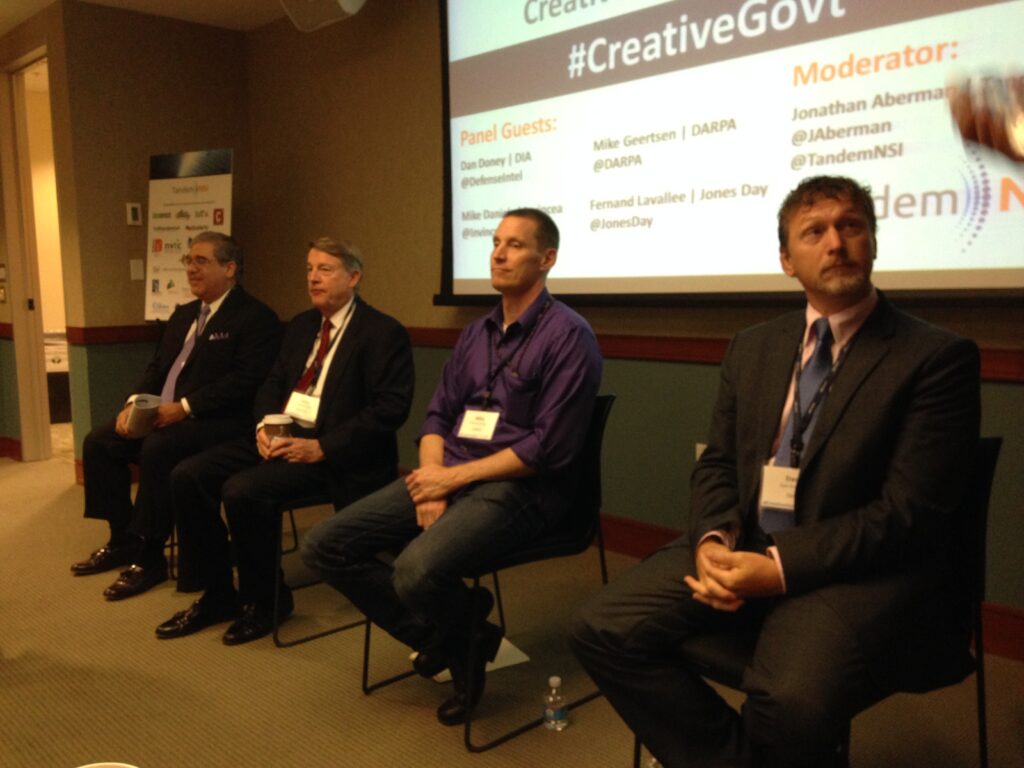Pentagon Struggles To Get Small-Biz Tech
Posted on

WASHINGTON: The Pentagon is not nimble. That’s more of a problem than ever in an era where even terrorist groups can increasingly download, buy, or steal sophisticated technology. So how can America’s bureaucratic military stay ahead? While Congress is wrestling with acquisition reform, some experts both inside the Pentagon and out argue that there’s more freedom to innovate within the existing system than most people think.
“Don’t let the contracting officer or acquisition officer tell you something without showing it to you in print,” said Alan Shaffer, the acting assistant secretary of defense for research and engineering, in remarks to industry group AFCEA this week. “A lot of times the government person wraps themselves around the DFARS [Defense Federal Acquisition Regulation Supplement] and the tyranny of acquisition regulations when in fact they’re not restricted from doing something.”
“There’s a tremendous amount of flexibility in the existing tools that are available,” lawyer Fernand Lavallee told another industry audience on Thursday. Even in traditional procurement contracts, there’s a lot more flexibility than most contractors and agencies take advantage of,” he said. “But there are also tools that are meant specifically to be extremely flexible,” such as Other Transaction Authority (OTA).
The barriers are often less legal or regulatory than cultural and psychological, both men agreed. “It’s not that they don’t know about it” (OTA), said Lavallee. “They’re afraid to use it.”
How big is that fear factor? “In my experience, it’s huge and it’s debilitating,” Lavallee told me when I approached him after Thursday’s discussion, hosted by TandemNSI. For example, for years after the notoriously scathing Sen. John McCain hammered the Army for misusing Other Transaction Authority in its disastrously over-ambitious Future Combat Systems program (FCS), Lavallee said, people were scared of using OTA where it was actually appropriate.
Businesses also miss opportunities out of fear of the unknown, added fellow panelist Mike Daniels, a veteran of DARPA and SAIC who now advises companies in the DC area, Silicon Valley, and Chicago. “The government is a massive buyer of advanced technology,” he told me after the discussion, “[but] most companies make the decision, in my experience, that they’re just going to focus either 100 percent on government [business] or 100 percent on commercial.”
Daniels urges his clients not to rule out government business as too difficult to get. As a starting point, he said, most agencies have genuinely helpful small business offices, and a small company seeking federal work can get by hiring just a couple of consultants: at a minimum, one lawyer familiar with federal contracting and one expert in compliance with federal financial and accounting standards.

Left to right: Fernan Lavallee, Jones Day; Mike Daniels; Mike Geertsen, DARPA; and Don Doney, Defense Intelligence Agency.
Contracting Catch-22
How do you get to “yes” under the current system? To start with, you have to ask. That’s not as simple as it sounds when it comes to new and innovative technologies, which often come out of new and obscure companies with no experience on federal contracts.
“It turns out the biggest source of the best ideas is ‘non-traditional performers,'” companies with no prior federal contracts, said Dan Doney, chief innovation officer at the Defense Intelligence Agency, speaking alongside Lavallee. “They really don’t know much about the way that we do business and we don’t know they exist.”
So “the first problem with acquisition is that we only get what we know to ask for,” Doney continued. “The second problem we have with acquisition is it’s hard to ask…I’ve got to generate an RFP [Request For Proposals] or a BAA [Broad Area Announcement] and that’s a six- to nine-month process.”
To shortcut that process, DIA set up a website called “NeedipeDIA” to match needs identified by agency personnel with solutions submitted by private companies. “We did the normal FAR-compliant Broad Agency Announcements,” Doney said, but instead of specifying what they were looking for, DIA basically inserted “see website” so anything posted on NeedipeDIA would fall under the BAA. That opened the door to some great ideas, he said – but the problem has been getting them on contract.
Just this week, Doney had brokered a meeting between agency officials and a tech company with a new approach to video conferencing. That’s a big deal at DIA, which often has to convene widely scattered experts in a hurry to analyze unexpected crises like Crimea. “They came to us and showed their capability yesterday and in fact it is much cheaper, it’s much more capable, it’s particularly well suited to low-bandwidth networks,” said Doney. But the culture clash was so profound that “I had to broker the exchange to keep people from walking out of the room.”
Doney described how the drive for innovation broke down in “minutes” of the DIA officials starting to ask questions:
DIA: “Are you accredited?”
Techie: “Accredited, what does that mean, accredited? People are using my technology….”
DIA: “We don’t buy things unless they’re accredited [by the government].”
Techie: “How do I get accredited?”
DIA: “Well, you need to go through this process… ”
Techie: “How do I start this process?”
DIA: “Well, someone needs to buy you[r product] so you can get accredited.”
The room erupted in rueful laughter.
To cut the knot of this Catch-22, Doney said, DIA is borrowing some rapid-contracting ideas from a DARPA experiment called “Cyber Fast Track.” Once that mechanism is grafted to NeedipeDIA, he said, “that six to nine months we can now get down to a a day to ask and … hopefully… seven days to contract.”
“Under certain scenarios,” Doney added quickly. “My acquisition folks freak out every time every time I talk about my goal…They say ‘stop saying a [specific] number of days.'”
“What I think is really needed long term is a persistent on-ramp” – to bring in new ideas — “and a whole fulfillment cycle” to get those ideas on an appropriate contract,” said Mike Geertsen, a software industry veteran now at DARPA. “That whole road map hasn’t been built yet.”

Strategic Surprise
That gap between good idea and signed contract has strategic implications. Decades ago, the American government drove high-tech breakthroughs like the space program and the Internet, but today, thanks to that Internet, “the barriers to innovation are dropping at all levels,” Geertsen said. You can take online courses to get up to speed, then outsource or crowdsource everything from design work to marketing, manufacturing, and distribution. A Taliban with a good web connection, he said, “can pretty much go the whole cycle of innovation now.”
In the information age, agreed Doney, scattered individuals can raise funds and coordinate projects that would once have required government backing. “The cost of communication, the cost of coordination, has radically changed,” he said. “It was simply the domain of state actors, of large research efforts funded by the government, to put a man in space. That’s changed. And the reason for that is it’s so much easier to coordinate, so much easier to tap into the best ideas wherever they sit.”
“If we as a government cannot tap into that…we’re going to be on the wrong side of disruption,” Doney warned. “We want to be on the right side of disruption, in other words harness it for the good of our nation. We have to fundamentally change [or] we’re going to be…. strategically surprised and have 9/11 after 9/11.”
Subscribe to our newsletter
Promotions, new products and sales. Directly to your inbox.
